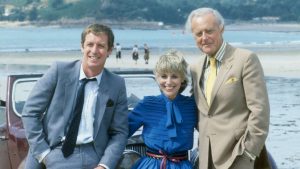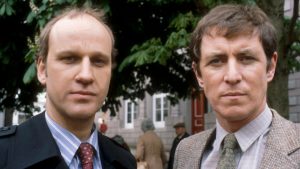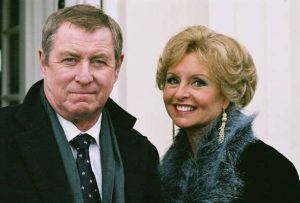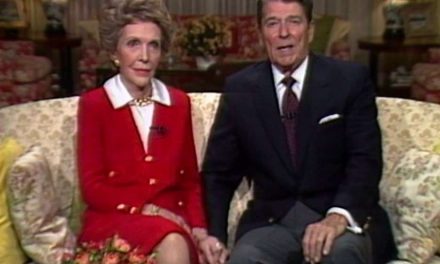When that estimable curator of classic British television, the Drama channel, began repeating Jersey-based detective series Bergerac (BBC, 1981-91) earlier this year, the Radio Times was less than laudatory, claiming the first episode showed ‘every one’ of its thirty-seven years.
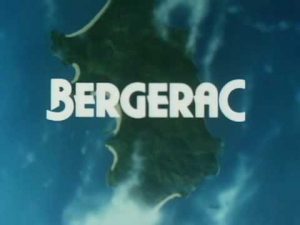 I, however, have a great deal of affection for Bergerac. By the late 80s it had replaced Doctor Who as the show my grandad and I would discuss over the phone on a Sunday – and I’m sure we weren’t alone in that. Conceived as a replacement for Shoestring (BBC, 1979-80) after Trevor Eve signed off, Bergerac starred John Nettles as the titular ’tec (first name Jim), and went on to become one of the most popular shows of the 1980s – working wonders for Channel Island tourism in the process.
I, however, have a great deal of affection for Bergerac. By the late 80s it had replaced Doctor Who as the show my grandad and I would discuss over the phone on a Sunday – and I’m sure we weren’t alone in that. Conceived as a replacement for Shoestring (BBC, 1979-80) after Trevor Eve signed off, Bergerac starred John Nettles as the titular ’tec (first name Jim), and went on to become one of the most popular shows of the 1980s – working wonders for Channel Island tourism in the process.
So, is Bergerac is a classic, or – as the RT would have us believe – a somewhat dated relic of a bygone age? It probably depends on one’s definition of the word ‘classic’. A text of the highest quality? At the time Bergerac was originally shown, pundits would probably have said yes – in terms of production values, at least. It was filmed, not just single camera (which in the early 1980s had yet to supersede multi-camera videotape as the production model of choice), but also on a (for the time) glamorous and exotic overseas location.[1]
On the other hand, if we take ‘classic’ to mean a text that is representative of its type, Bergerac also ticks several detective series boxes. Lead character Jim possesses all the readymade psychological baggage one would expect of the genre; he not only has a drink problem, but also a gammy leg AND a resentful ex-wife, Deborah (played by Deborah Grant). The latter two are, of course, largely a result of the first. He also has a young daughter, Kim (Lindsay Heath), and an ex-father-in-law, shady businessman Charlie Hungerford (wonderfully essayed by the late Terence Alexander), who seems to be peripherally involved in pretty much every crime Jim is called upon to investigate.
Although a dedicated detective, always ready to act on a hunch, Jim consistently fails to achieve promotion because he doesn’t play by the rules, with the result that his former partner, career copper Barney Crozier (Sean Arnold), smoothly ascends to the rank of Chief Superintendent while Jim is left typing up crime reports.
What else? Jim drives a vintage Triumph Roadster, doesn’t have much luck with women because the job always somehow comes first, and, along with everyone else on the island (cops and villains alike), regularly hangs out at a small brasserie called The Royal Barge, which is run by the one-appearance-an-episode Diamante Lil (Mela White).
The show also had an extremely catchy theme tune, in which George Fenton put a suitably Gallic spin on the then-current reggae-inflected pop of bands like The Police. Think ‘Walking on the Moon’ meets a lurching accordion version of ‘Je T’Aime’ (without the grunting). You’ll be humming it all day.
So far, so formulaic. But every genre piece requires a twist, and in Bergerac this is provided by the fact that, rather than being situated in a bustling metropolis or a sleepy village like its contemporaries, the crime drama action plays out on a sun-kissed (most of the time) holiday island. Jersey measures just 119.5 square kilometres, which – given the volume of crimes Jim investigates – must make it one of the most dangerous away break destinations in Europe.
If this is all you know of the show, you will, like that Radio Times reviewer, probably be ready to write it off by now.
But hold hard. Because over its nine series, Bergerac transcended its slightly contrived origins, and creator Robert Banks Stewart’s initial ‘cop on an island’ concept gradually blossomed to become a jewel in the crown of the BBC’s Saturday evening line-up (and the centrepiece of my Sunday phone calls).
So, how did that happen?
For starters, what might seem on paper like a slightly cardboard cut-out set-up had life breathed into it by an extremely talented crew. Over the decade it was in production, Bergerac played host to a number of industry legends, plus several stars-in-waiting. Directors included Tistan De Vere Cole, Ben Bolt, Martyn Friend, Don Leaver, Geoffrey Sax, Matthew Robinson and Gordon Flemyng. In addition to Banks Stewart, Rod Beacham, Dennis Spooner, Robert Holmes, Bob Baker, Chris Boucher, Terence Feely, Brian Clemens and Ian Kennedy Martin all contributed scripts. And as for the thesps… well, it’s difficult to know where to begin, though Ian Hendry, in one of his last great performances, is probably a safe bet (‘Campaign for Silence’, series one), and the final episode provided a notable role for that young shaver Bill Nighy.
Above all, Bergerac was a series that was given the time and space to breathe and grow – not a luxury now afforded to shows that fail to make an immediate impact with viewers. In the days before complex narratives and character arcs (Jim solved a different crime each week; that was pretty much it), regular viewers could not help but pick up on the gradual thaw in relations between Jim and his estranged family. In episode one, Hungerford is angry and resentful over what he perceives as the way Jim’s self-destructiveness has damaged his wife and daughter, cutting an almost menacing figure – yet by the end of series one we share his awkwardness as he provides Jim with the surprisingly thoughtful gift of a bottle of alcohol-free wine. Publicising the series in the Radio Times, Terence Alexander later reflected approvingly upon Charlie’s slow transformation from a ‘hard man’ into a comic relief foil, and the sparring that frequently occurs when Jim is investigating one of Charlie’s dodgy deals or contacts[2] is increasingly underpinned by an underlying sense of mutual affection. While, in the series three opener ‘Ninety Per Cent Proof’, Charlie is disgusted when it seems that Jim is back on the bottle,[3] chiding Deborah as she helps her ex dry out, by the 1991 finale, ‘All for Love’, it is he who steps in when Jim hits the sauce for real, this time actively enlisting Deborah’s help.
Deborah’s character development is less straightforward. For the first two years she is very much the frosty ex-wife, disapproving of Jim’s new loves (Francine (Cecile Paoli) in series one, Marianne (Celia Imrie) in series two). Then, in series three, there are strong hints of a rapprochement, and Deborah becomes a far more sympathetic character as Jim makes an effort to spend quality time with her and Kim (Lindsay Heath also deserves honourable mention for her portrayal of Bergerac Junior’s development from doting kiddie, through awkward adolescence, to stroppy teen). However, this promising turn is abandoned entirely in series four with the arrival of estate agent Susan Young (the always excellent Louise Jameson) as Jim’s new love. In one of the show’s few bum notes, Deborah is now repurposed as a tipsy society girl, forever flirting with inappropriate playboy types in Diamante Lil’s new nightclub (the imaginatively-named Lil’s Place; another poor move). It is a tribute to the acting abilities of Deborah Grant that the character retains some audience sympathy, the implication being that her tippling is motivated by jealousy of Susan, and the flirting an (at times successful) attempt to arouse the green-eyed monster in Jim. So pronounced does Deborah’s drinking (Jim’s character flaw, remember) become that few people initially believe her when she says she is being terrorised in the series five episode ‘Root and Branch’, in which Christopher Fairbanks’ recently released con ultimately takes her, Kim and Charlie hostage in a bid for revenge against Jim.
Incidentally, this was Grant’s last appearance as a series regular, but Deborah still popped up periodically. It was always nice to see her, especially in the series finale – but more of that later.
The character of Susan proved to be far more durable than Jim’s previous partners,[4] though like others before her there were limits to her patience. Given Jim’s devotion to duty, this was entirely understandable – though I’m sure we all felt a little let down when, in the series five closer, ‘Poison’, she was revealed to have cheated on him (my grandad was especially disappointed; we were both admirers of Louise Jameson due to her performance as Leela in Doctor Who, though possibly for different reasons). Nonetheless, we continued to root for the couple as they struggled, unsuccessfully, to reconcile over the next two years. Susan’s shock departure from the show in the series eight opener (another major telephonic talking point) set in motion a chain of events that ultimately saw Jim leaving the force and setting up as a private eye in France for the final run of episodes.
Other regulars were equally well drawn. Jim’s relationship with Barney could have been one of straightforward rivalry/hostility, but proved to be a little more complex. It is made clear in the opening episode that the two were, until recently, partners on an equal footing, with a reasonably sound working relationship. Perhaps aware that Jim is the better cop – and not wanting to be shown up – the newly promoted Barney is reluctant to have his colleague back on the force after the accident in which Jim injured his leg.[5] For his part, Jim expresses contempt both for Barney’s ‘by the book’ approach, and resentment of the fact that this seems to have facilitated his accelerated promotion (Jim of course applied for Barney’s job, but didn’t get it). However, there are occasional intimations that the two were formerly on good terms. They know each other’s wives, and a rueful Barney is happy to take a ribbing from Jim and Cecile over his enthusiasm for model airplanes. While Barney slowly becomes more distant as he climbs the greasy pole, he does not take advantage of the several opportunities he is given to bounce the maverick Jim off the force for his unorthodox methods – and even turns a blind eye when Jim beats up the man responsible for framing him in ‘Ninety Per Cent Proof’.
The same depth of characterisation also applied to supporting and recurring personnel. As a cheery Greek chorus for Jim to unload onto, bar proprietor Lil could have been a dreary cipher, yet Mela White turns her into a fully rounded character. Note her initial suspicion of the newly solicitous Deborah in ‘Ninety Per Cent Proof’; a sign that not everyone blames Jim for the break-up of his marriage. Bernard Archard clearly enjoys his two appearances as sarcastic pathologist Dr Rogers, making no attempt to mask his disdain for Bergerac’s detective abilities, while Lee Montague is always good value as Jim’s avuncular French colleague, Detective Inspector Dupont. In early episodes Annette Badland is cheery and redoubtable as receptionist Charlotte, into whose love life we get a brief glimpse in ‘Fall of a Birdman’ (inevitably, her former squeeze – played by Richard Griffiths – turns out to be a wrong ‘un). Charotte was replaced from series four by the initially prim Peggy (Nancy Mansfield), who is given her own character arc via the (off-screen) death of her husband, and a subsequent, slow-burning romance with Charlie (whom she always addresses as Charles).
My favourite, though, is plodding plainclothes detective constable Terry Wilson (Geoffrey Leesley), who can usually be guaranteed to lose whichever suspect he is tailing over the first three series. In series four Terry seems at first to have been replaced by the younger, more photogenic Barry Goddard (Jolyon Baker); the two characters are pretty much interchangeable, and one might be forgiven for assuming that Leesley had moved on to pastures new. Then Terry unexpectedly crops up again, now bearded, in ‘Return of the Ice Maiden’ – an episode that does not feature Barry (I don’t know how many other viewers were beginning to wonder why we never saw Terry and Barry together by this point, but my grandad and I certainly were. To us, this mystery was just as engrossing as the actual plots). Then, in the 1986 Christmas special ‘Fires in the Fall’, the two finally meet on-screen, revealed to enjoy a professional rivalry that should have been made more of by the writers.
When the show returned in 1988, Terry and Barry had vanished, replaced by new detectives Ben Lomas (David Kershaw) and Willy Petit (John Telfer). A slightly square mummy’s boy and a smooth chancer, these were far more fully developed characters, and saw the series out to the end of its run. All good stuff, but grandad and I still missed Tez and Baz.
The ultimate in returning characters is probably diamond thief Philippa Vale (Liza Goddard), who clocked up six appearances between 1983 and 1989. In a relationship that gradually develops from mild ‘opposites attract’ flirting to a full-on pash (see ‘Treasure Hunt’ for the steamy stuff), Jim and Philippa are the couple that Bergerac viewers really wanted to see get together. What could be a one-dimensional guest villainess is transformed by Goddard’s playful yet multi-layered characterisation (Philippa targets high society not just because they have more money, but because it was the smart set that brought about the downfall of her artist father), and her on-screen chemistry with John Nettles means that things always perk up when the Ice Maiden puts in an appearance. It is a shame that, after delivering a ‘use him or lose him’ ultimatum to Susan in ‘Old Acquaintance’, Philippa doesn’t feature in any further episodes.
So, a rich character confection indeed. However, as the years passed and the creative team’s confidence grew, Bergerac also became notable for its dabbling in genres other than crime drama. These included comedy (witness guest star Tony Robinson’s turn in ‘My Name’s Sergeant Bergerac’), noir (the afore-mentioned ‘All for Love’) and several forays into horror territory. The first of these was ‘What Dreams May Come?’, which heavily channels Dennis Wheatley in an occult tale of spontaneous combustion starring Charles Gray (who had also featured in Hammer’s adaptation of Wheatley’s The Devil Rides Out). This atmospheric strain later continued via ‘Fires in the Fall’ and ‘The Dig’.
By series five, Bergerac was arguably at its peak. It couldn’t last, of course, and the replacement of producer Jonathan Alwyn (who oversaw series three to five: the glory years) with George Gallacio was, for me, the beginning of a gradual decline. The decision to re-record the theme tune was probably the turning point; now utilising a drum machine and electric piano, it resembled nothing so much as Stock, Aitken and Waterman on Mogadon. Diamante Lil, Kim, Terry and Barry had all made their final appearances the previous year, and many other semi-regulars now began to float away, even Peggy ultimately jumping ship (perhaps disappointed that things hadn’t worked out with Charlie). After Barney’s departure (promoted yet again, and now also bearded) in the 1990 Christmas special, only Jim and Charlie were left of the original line-up, and the series nine genre shift – from Jersey police detective to France-based investigator – meant that much of the show’s original appeal became diluted. By this time Jim had yet another romantic partner, wine heiress Danielle (Therese Leotard), and at last seemed to have found a measure of contentment. However, the series finale, ‘All for Love’, abruptly abandoned this cosy set-up. Dumped off-screen for another man (a move that felt out of character for the hitherto sympathetically portrayed Danielle), Jim hits the bottle with bitter abandon, and makes a total hash of his new job as Charlie’s minder in a suspect art deal. He even starts an affair with a femme fatale. Perhaps inevitably, the formerly upstanding copper ends up framed for murder. Fortunately, Jim eventually sobers up and comes to his senses, but has to be helped out in the closing Mexican stand-off by none other than the newly returned Deborah, who (pleasingly) he introduces to the villains as Mrs Bergerac.
After ten years, the series comes to a close with Jim earmarked for a high-ranking job back on the Force (promotion at last!), and the intimation that he and Deborah are finally reaching a point of reconciliation. If, like so much about Bergerac, this sounds somewhat contrived, it at least brought to a close two of the story strands that had been dangling since 1981, rewarding long-standing viewers with a sense of closure.
Two years later an episode of the Jasper Carrott/Robert Powell comedy The Detectives (BBC, 1993-97) saw John Nettles and Terence Alexander reprising their old roles when Louis and Briggs were sent to Jersey for their latest case – but this was ersatz Bergerac at best. Despite rumours of a remake a few years ago, for the time being fans must console themselves with the Drama repeats (we are up to series five as I write – for my money, the strongest of the run). John Nettles went on to portray another iconic detective, Tom Barnaby, in Midsomer Murders (ITV, 1997- ), but while this provided the occasional guest role for former Bergerac luminaries, including Liza Goddard and Geoffrey Leesley, the hoped-for (by me) appearances from Sean Arnold, Deborah Grant and Louise Jamieson never materialised.
Ah, well; Radio Times be damned. Perhaps not every episode is a classic, but vintage Bergerac still deserves its place in the great wine cellar of TV history. Here is my top ten selection:
- ‘Ninety Per Cent Proof’, episode 3.1. I have mentioned it repeatedly in this blog, but this was the big one. Opening series three, it marked the beginning of Jonathan Alwyn’s stylish tenure, and its move from Sunday evening to the Saturday prime time slot cemented Bergerac’s reputation as ‘must see’ TV. Some baddies get Jim drunk in order to discredit him, but Deborah is on hand to set him back on track.
- ‘Winner Takes All’, episode 5.2. This was the great Robert Holmes’ last script for the series; the episode was screened posthumously. Michael Gambon is a grumpy computer programmer receiving death threats, and Connie Booth his trophy wife. Hilarious to watch now due to everyone’s incomprehension of how PCs work, but don’t get too comfortable; there are some nasty shocks in store.
- ‘Ice Maiden’, episode 3.4. Any Philippa Vale episode is worth a look, but the first is possibly the best. The beach scene is my favourite; Nettles and Goddard are already sparking off each other. It is also probably Terry’s finest hour, being given the slip by Philippa in a library.
- ‘Fires in the Fall’, Christmas special 1986. Proper creepy, as the young people probably say, and you get to see Margaretta Scott (Mrs Pomfrey from All Creatures Great and Small) alongside a young Amanda Redman (with a very dodgy hairdo).
- ‘Holiday Snaps’, episode 3.3. Why is Michael Angelis being victimised following the brutal murder of his wife on a campsite? It’s lovely to see Charlie getting jealous of Dupont at Kim’s birthday party, and the young Heath is, for once, given a chance to show her acting chops.
- ‘Root and Branch’, episode 5.3. Jim’s family are being targeted by nasty Christopher Fairbanks, but they are none too pleased when he sweeps in to the rescue.
- ‘Off Shore Trades’, episode 4. 2. Ian McCulloch is much better here as an Ozzie surfer than he was in the Doctor Who story ‘Warriors of the Deep’. Much better. Terence Alexander is also on very good form, and there a very dark ending. Bergerac wasn’t playing it safe any more.
- ‘Campaign for Silence’, episode 1.4. The first episode to approach classic status, due largely to guest star Ian Hendry’s bravura performance as a retired military man being victimised by the top brass after writing a ‘tell all’ memoir.
- ‘A True Detective’, episode 8.1. This is probably the best of the later episodes, if only for the dramatic nature of Susan’s exit. You won’t see it coming.
- ‘All for Love’, Christmas special 1991. The final episode. There are better stories in the earlier series, but this has to be seen if only for the strong dynamic that by now exists between John Nettles, Terence Alexander and Deborah Grant. An uneven treat for hardcore fans.
Dr Richard Hewett is Lecturer in Media Theory at the University of Salford’s School of Arts and Media. He has contributed articles to The Journal of British Cinema and Television, The Historical Journal of Film, Radio and Television, Critical Studies in Television and Adaptation. His first monograph, The Changing Spaces of Television Acting, was published by Manchester University Press last year. For a full list of publications, see https://salford.academia.edu/RichardHewett.
Footnotes:
[1] Or at least across the channel.
[2] My teenage impression of Nettles and Alexander’s weekly repartee – ‘’Ullo, Charlie. What’s going on ‘ere, then?’ ‘Aye, ’ello Jim.’ – always made my grandad laugh. Though it now seems possible that he was humouring me.
[3] It’s OK; he was framed by some baddies – including that nasty Ray Winstone.
[4] Jim really doesn’t learn from past mistakes in his relations with women – but then that was rather the point of series drama in those days.
[5] A plot device that disappeared fairly sharpish. I remember him getting in trouble for missing a medical check-up in series two, but after that I don’t think it was mentioned again…


